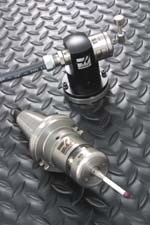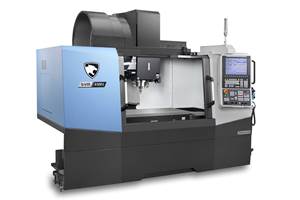System Simplifies Probing Operations On VMCs
Few machinists will dispute the merits of probing for speeding part setup, setting tool offsets and performing in-process inspection . . . at least in theory. In practice, however, probe systems often have been viewed as difficult to use and expensive to buy.
Few machinists will dispute the merits of probing for speeding part setup, setting tool offsets and performing in-process inspection . . . at least in theory. In practice, however, probe systems often have been viewed as difficult to use and expensive to buy. As a result, they've become tools used primarily by experienced programmers in high-production environments.
The Visual Quick Code probing system from Haas Automation, Inc. (Oxnard, California) is designed to make probing effective and more affordable to a wide range of users. The system was recently developed in conjunction with Renishaw, a leader in probe systems.
Available as an option on new Haas vertical machining centers, the system consists of a spindle probe, a contact tool setting probe, an optical receiver and Renishaw's Inspection Plus software. The system is installed and calibrated at the machine tool builder's factory.
The system features a conversational programming system that uses a graphical interface and a question/answer format to create G-code programs. It does not require knowledge of macro programming. The machinist creates probe routines for tool setting and part setup by entering basic information with the keyboard on the CNC.
For example, to probe the external corner of a workpiece and establish a work offset, the machinist selects the appropriate graphical template, jogs the spindle probe to within 0.5 inch of the selected corner and enters the following information: work offset number (for example, G54), approximate X width of the material, approximate Y width of the material and which corner to probe. Once this information is entered, a pop-up dialog box prompts the machinist to choose where to output the G code: to a new program, to an existing program or directly to manual data input (MDI). Once a destination is selected, the G code is generated automatically for the probe routine.
If the G code is used as direct data input, the machinist hits Cycle Start to probe the workpiece and automatically enter the correct offsets into the control. If the machinist chooses to create a new program, the program can be called up immediately to start the probe routine, or saved for later use. If the G code is inserted into an existing part program, it can be used to probe each workpiece and update the offsets prior to machining.
The system also has templates for finding the center of a workpiece, probing a bore or boss, measuring bore-to-bore or boss-to-boss and probing a web or pocket.
The procedure for setting tool offsets follows a pattern very similar to the procedure for setting work offsets, with templates for automatically measuring tool length, tool diameter or both. The machinist can measure tools individually or create a probe routine to check a carousel of tools.
The company points out that despite the very favorable pricing, the system is considered a full-featured, high-resolution probe system capable of many other probing tasks in addition to tool and part setting. Using macros (included) and advanced programming methods, it can perform such operations as in-process tool and part inspection, first-off part measurement, automatic compensation for thermal changes and checking for worn or broken tools. This functionality reduces operator-induced variations in the process and builds confidence in unattended machining processes.
Related Content
Positioned to Prevail: Designing Processes Around People
Stecker Machine Company shows that getting the most value from employees means valuing your employees.
Read MoreDN Solutions Introduces High-Productivity Vertical Machining Center
The SVM 5100L’s performance has been optimized to reduce the acceleration/deceleration times of the XYZ axes and spindle, reducing non-cutting time.
Read MoreLean Approach to Automated Machine Tending Delivers Quicker Paths to Success
Almost any shop can automate at least some of its production, even in low-volume, high-mix applications. The key to getting started is finding the simplest solutions that fit your requirements. It helps to work with an automation partner that understands your needs.
Read MoreWatchmaking: A Machinist’s View
Old-world craftsmanship combines with precision machining on a vertical machining center and Swiss-type lathe to produce some of the only U.S.-made mechanical wristwatch movements.
Read MoreRead Next
3 Mistakes That Cause CNC Programs to Fail
Despite enhancements to manufacturing technology, there are still issues today that can cause programs to fail. These failures can cause lost time, scrapped parts, damaged machines and even injured operators.
Read MoreThe Cut Scene: The Finer Details of Large-Format Machining
Small details and features can have an outsized impact on large parts, such as Barbco’s collapsible utility drill head.
Read More
















.png;maxWidth=300;quality=90)










